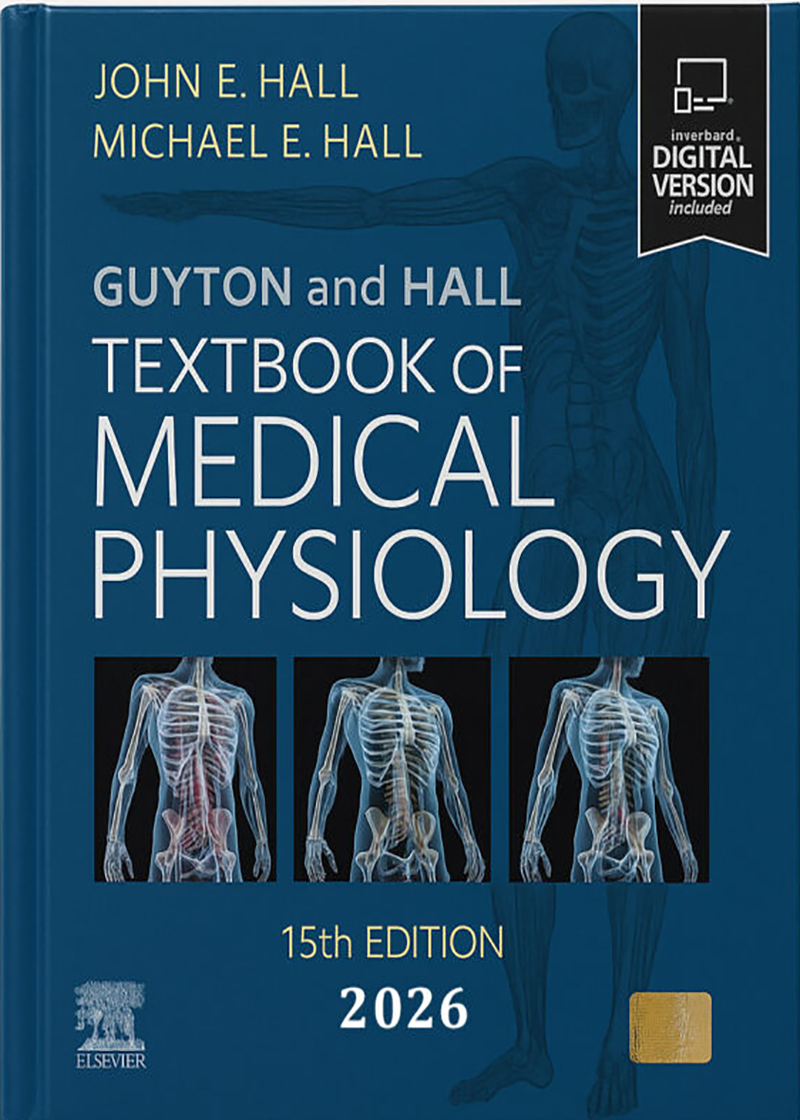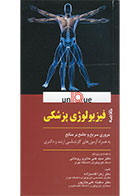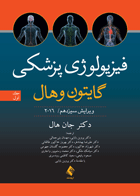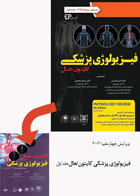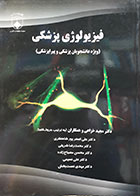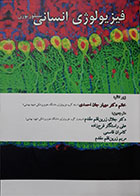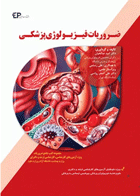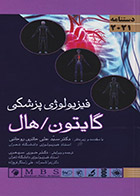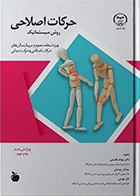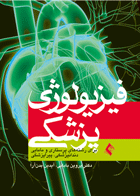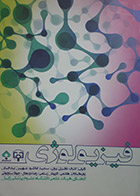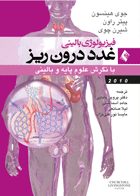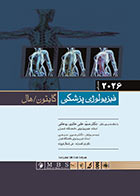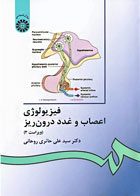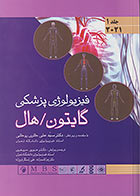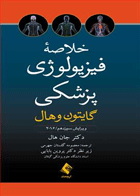کتاب زبان اصلی گایتون 2026 Guyton and Hall Textbook of Medical Physiology Review
دسته بندی : فیزیولوژی
نویسنده : John E Hall
انتشارات : انتشارات Elsevier
سال چاپ : 2026
نوبت چاپ : اول
قطع : وزیری
شابک : 9780443111013
تعداد صفحات 1165 صفحه انتشارات Elsevier تألیف John E. Hall
-
ارسال سریع
ارسال سریع با پست
-
پرداخت امن
پرداخت از طریق درگاه های بانکی
کتاب زبان اصلی گایتون 2026 Guyton and Hall Textbook of Medical Physiology Review
کد p00967
تعداد صفحه 255
وزن 892
تألیف John E. Hall
انتشارات Elsevier
ویرایش سیزدهم
چاپ پانزدهم
سال 2026
موضوعات
فیزیولوژی
درباره کتاب زبان اصلی گایتون 2026 Guyton and Hall Textbook of Medical Physiology Review
کتاب فیزیولوژی پزشکی گایتون و هال بسیار بین دانشجویان پزشکی در سراسر جهان محبوب است چرا که دانش پیچیده ی فیزیولوژی را با زبانی شیوا و نسبتا ساده برای دانشجویان فابل فهم تر کرده است. ویرایش پانزدهم این کتاب دارای ساختاری منسجم و بیانی ساده است و تمرکز مطالب به طور کامل بر روی مطالب و محتواهای مورد نیاز دانشجویان بالینی و پیش بالینی است. گرافیک و صفحه آرایی کتاب به صورتی است که ارتباط گیری با مطالب بسیار آسانتر است به این ترتیب که مطالب و عناوین اصلی با فونت بزرگتر درج شده اند و اطلاعات پشتیبان با فونت کوچکتر و رنگ آبی کمرنگ. با این گرافیک مرور سریع مطالب برای دانشجویان بسیار آسانتر شده است.
ویژگیهای کلیدی کتاب زبان اصلی گایتون 2026 Guyton and Hall Textbook of Medical Physiology Review
- با تمرکز بر مطالب اصلی و چگونگی حفظ هموستاز بدن برای سالم ماندن، بر اصول مهمی تأکید میکند که در تصمیمگیریهای بالینی بعدی به شما کمک خواهد کرد.
- حاوی اطلاعات جدیدی در مورد فیزیولوژی و میکروبیوم روده و تفاوتهای جنسی از نظر بالینی مهم در مقادیر آزمایشگاهی فیزیولوژی است.
- اطلاعات را در فصلهای کوتاه با استفاده از صدایی مختصر و خوانا ارائه میدهد که یادگیری و حفظ مطالب را تسهیل میکند.
- از دو اندازه فونت استفاده میکند : یک فونت بزرگتر برای اصول اولیه و یک فونت کوچکتر که علوم مرتبط، مثالهای بالینی، پاتوفیزیولوژی یا مکانیسمهای دقیق را برجسته میکند تا دانشجویان در صورت نیاز بتوانند آنها را مطالعه کنند.
- شامل بیش از ۱۲۰۰ نقاشی و نمودار تمام رنگی است که همگی با دقت طراحی شدهاند تا درک فیزیولوژی را آسانتر کنند.
فهرست مطالب
UNIT I: Introduction to Physiology: The Cell and General Physiology
1. Functional Organization of the Human Body and Control of the “Internal Environment”
Cells Are the Living Units of the Body
Extracellular Fluid—The “Internal Environment”
Homeostasis—Maintenance of a Stable Internal Environment
Control Systems of the Body
Physiological Variability
2. The Cell and Its Functions
Organization of the Cell
Cell Structure
Functional Systems of the Cell
Locomotion of Cells
3. Genetic Control of Protein Synthesis, Cell Function, and Cell Reproduction
Cell Nucleus Genes Control Protein Synthesis
Transcription—Transfer of Cell Nucleus DNA Code to Cytoplasm RNA Code
Translation—Formation of Proteins on the Ribosomes
Protein Enzymes Control Synthesis of Other Substances in the Cell
Regulation of Gene Function and Biochemical Activity in Cells
The DNA–Genetic System Controls Cell Reproduction
Cell Differentiation
Apoptosis—Programmed Cell Death
Cancer
UNIT II: Membrane Physiology, Nerve, and Muscle
4. Transport of Substances Through Cell Membranes
The Cell Membrane Is a Lipid Bilayer With Cell Membrane Transport Proteins
Diffusion
Active Transport of Substances Through Membranes
5. Membrane Potentials and Action Potentials
Basic Physics of Membrane Potentials
Resting Membrane Potential of Neurons
Neuron Action Potential
Propagation of the Action Potential
Importance of Energy Metabolism for Reestablishing Sodium and Potassium Ionic Gradients After Action Potentials Are Completed
Plateau in Some Action Potentials
Rhythmicity of Some Excitable Tissues—Repetitive Discharge
Special Characteristics of Signal Transmission in Nerve Trunks
Excitation—The Process of Eliciting the Action Potential
6. Contraction of Skeletal Muscle
Physiological Anatomy of Skeletal Muscle
General Mechanism of Muscle Contraction
Molecular Mechanisms of Muscle Contraction
Energetics of Muscle Contraction
Characteristics of Whole Muscle Contraction
7. Excitation of Skeletal Muscle: Neuromuscular Transmission and Excitation-Contraction Coupling
Neuromuscular Junction and Transmission of Impulses From Nerve Endings to Skeletal Muscle Fibers
Muscle Action Potential
Excitation-Contraction Coupling
8. Excitation and Contraction of Smooth Muscle
Contraction of Smooth Muscle
Regulation of Contraction By Calcium Ions
Nervous and Hormonal Control of Smooth Muscle Contraction
UNIT III: The Heart
9. Cardiac Muscle; The Heart as a Pump and Function of the Heart Valves
Cardiac Muscle Physiology
The Cardiac Cycle
Regulation of Heart Pumping
10. Rhythmical Excitation of the Heart
Specialized Excitatory and Conductive System of the Heart
Control of Excitation and Conduction in the Heart
11. Fundamentals of Electrocardiography
Waveforms of the Normal Electrocardiogram
Flow of Current Around the Heart During the Cardiac Cycle
Electrocardiographic Leads
12. Electrocardiographic Interpretation of Cardiac Muscle and Coronary Blood Flow Abnormalities: Vectorial Analysis
Vectorial Analysis of Electrocardiograms
Vectorial Analysis of the Normal Electrocardiogram
Mean Electrical Axis of the Ventricular QRS and Its Significance
Conditions That Cause Abnormal Voltages of the QRS Complex
Prolonged and Bizarre Patterns of the QRS Complex
Current of Injury on the Electrocardiogram
Abnormalities in the T Wave
13. Cardiac Arrhythmias and Their Electrocardiographic Interpretation
Abnormal Sinus Rhythms
Heart Block Within the Intracardiac Conduction Pathways
Premature Contractions
Paroxysmal Tachycardia
Ventricular Fibrillation
Atrial Fibrillation
Atrial Flutter
Cardiac Arrest
UNIT IV: The Circulation
14. Overview of the Circulation: Pressure, Flow, and Resistance
Physical Characteristics of the Circulation
Basic Principles of Circulatory Function
Interrelationships of Pressure, Flow, and Resistance
15. Vascular Distensibility and Functions of the Arterial and Venous Systems
Vascular Distensibility
Arterial Pressure Pulsations
Veins and Their Functions
16. The Microcirculation and Lymphatic System: Capillary Fluid Exchange, Interstitial Fluid, and Lymph Flow
Structure of the Microcirculation and Capillary System
Vasomotion Causes Intermittent Capillary Blood Flow
Exchange of Substances Between the Blood and Interstitial Fluid
Interstitium and Interstitial Fluid
Fluid Filtration Across Capillaries
Lymphatic System
17. Local and Humoral Control of Tissue Blood Flow
Local Blood Flow Is Controlled in Response to Tissue Needs
Mechanisms of Local Blood Flow Control
Humoral Control of the Circulation
18. Nervous Regulation of the Circulation and Rapid Control of Arterial Pressure
Nervous Regulation of the Circulation
Special Features of Nervous Control of Arterial Pressure
19. Role of the Kidneys in Long-Term Control of Arterial Pressure and in Hypertension: The Integrated System for Arterial Pressure Regulation
Renal–Body Fluid System for Arterial Pressure Control
Role of the Renin-Angiotensin System in Arterial Pressure Control
Summary of Integrated Multifaceted Systems for Arterial Pressure Regulation
20. Cardiac Output, Venous Return, and Their Regulation
Normal Values for Cardiac Output at Rest and During Activity
Control of Cardiac Output By Venous Return—Frank-Starling Mechanism of the Heart
Methods for Measuring Cardiac Output
21. Muscle Blood Flow and Cardiac Output During Exercise; The Coronary Circulation and Ischemic Heart Disease
Blood Flow Regulation in Skeletal Muscle at Rest and During Exercise
Coronary Circulation
22. Heart Failure
Circulatory Dynamics in Heart Failure
Unilateral Left Heart Failure
Low-Output Cardiac Failure—Cardiogenic Shock
Edema in Patients With Heart Failure
Cardiac Reserve
Quantitative Graphic Analysis of Cardiac Failure
Heart Failure With Preserved Ejection Fraction
High-Output Heart Failure
23. Heart Valves and Heart Sounds; Valvular and Congenital Heart Defects
Heart Sounds
Abnormal Circulatory Dynamics in Valvular Heart Disease
Abnormal Circulatory Dynamics in Congenital Heart Defects
Use of Extracorporeal Circulation During Cardiac Surgery
Hypertrophy of the Heart in Valvular and Congenital Heart Disease
24. Circulatory Shock and Its Treatment
Physiological Causes of Shock
Hypovolemic Shock Due to Hemorrhage
Distributive Shock Is Characterized By Severe Peripheral Vasodilation
Obstructive Shock Is Usually Due to Noncardiac Causes of Reduced Cardiac Output
Physiology of Treatment in Shock
Circulatory Arrest
UNIT V: The Body Fluids and Kidneys
25. Regulation of Body Fluid Compartments: Extracellular and Intracellular Fluids; Edema
Long-Term Steady-State Fluid and Solute Balance
Body Fluid Compartments
Constituents of Extracellular and Intracellular Fluids
Measurement of Body Fluid Volume—Indicator-Dilution Principle
Fluid Exchange and Osmotic Equilibrium Between Intracellular and Extracellular Fluid
Volume and Osmolality of Extracellular and Intracellular Fluids in Abnormal States
Glucose and Other Solutions for Nutrition
Clinical Abnormalities of Fluid Volume Regulation: Hyponatremia and Hypernatremia
Edema: Excess Fluid in the Tissues
Fluids in Potential Spaces of the Body
26. The Urinary System: Functional Anatomy and Urine Formation By the Kidneys
Functions of the Kidneys
Physiological Anatomy of the Kidneys
Urine Formation Results From Glomerular Filtration, Tubular Reabsorption, and Tubular Secretion
Micturition
27. Glomerular Filtration, Renal Blood Flow, and Their Control
Glomerular Filtration—The First Step in Urine Formation
Determinants of GFR
Renal Blood Flow
Physiological Control of GFR and Renal Blood Flow
Autoregulation of GFR and Renal Blood Flow
28. Renal Tubular Reabsorption and Secretion
Tubular Reabsorption Is Quantitatively Large and Highly Selective
Passive and Active Mechanisms of Reabsorption
Reabsorption and Secretion Along Different Parts of the Nephron
Regulation of Tubular Reabsorption
Use of Clearance Methods to Quantify Kidney Function
29. Urine Concentration and Dilution; Regulation of Extracellular Fluid Osmolarity and Sodium Concentration
Excretion of Excess Water by Dilute Urine
Conservation of Water by Concentrated Urine
Countercurrent Multiplier Mechanism
Control of Extracellular Fluid Osmolarity and Sodium Concentration
30. Renal Regulation of Potassium, Calcium, Phosphate, and Magnesium; Integration of Renal Mechanisms for Control of Blood Volume and Extracellular Fluid Volume
Regulation of Internal Potassium Distribution
Renal Potassium Excretion
Renal Calcium Excretion and Extracellular Calcium Ion Concentration
Renal Phosphate Excretion
Renal Magnesium Excretion and Extracellular Magnesium Ion Concentration
Integration of Renal Mechanisms for Control of Extracellular Fluid and Distribution of Extracellular Fluid
Nervous and Hormonal Factors in Renal–Body Fluid Feedback Control
Responses to Changes in Sodium Intake
Conditions Causing Large Increases in Blood and Extracellular Fluid Volume
31. Acid–Base Regulation
Hydrogen Ion Concentration Regulation
Acids and Bases—Definitions
Defenses Against Changes in H+ Concentration: Buffers, Lungs, and Kidneys
Buffering of H+
Bicarbonate Buffer System
Phosphate Buffer System
Proteins as Intracellular Buffers
Respiratory Regulation of Acid–Base Balance
Renal Control of Acid–Base Balance
Secretion and Reabsorption of H+ and HCO3− in Tubules
Generation of “New” HCO3− in the Tubule
Quantification of Renal Acid–Base Excretion
Renal Adjustment in Acidosis and Alkalosis
32. Diuretics and Kidney Diseases
Mechanisms of Action of Diuretics
Kidney Diseases
Acute Kidney Injury
Chronic Kidney Disease (CKD) and Loss of Nephrons
UNIT VI: Blood Cells, Immunity, and Blood Coagulation
33. Red Blood Cells, Anemia, and Polycythemia
Red Blood Cells (Erythrocytes)
Iron Metabolism
Anemias
Polycythemia
34. Resistance of the Body to Infection: I. Leukocytes, Granulocytes, the Monocyte-Macrophage System, and Inflammation
Leukocytes (White Blood Cells)
Neutrophils and Macrophages Defend Against Infections
Monocyte-Macrophage Cell System (Reticuloendothelial System)
Inflammation: Role of Neutrophils and Macrophages
Eosinophils
Basophils
Leukopenia
Leukemias
35. Resistance of the Body to Infection: II. Immunity and Allergy
Acquired (Adaptive) Immunity
Allergy and Hypersensitivity
Sex Differences in Innate and Adaptive Immunity
36. Blood Types, Transfusion, and Tissue and Organ Transplantation
Antigenicity Causes Immune Reactions of Blood
O-A-B Blood Types
Rh Blood Types
Transfusion Reactions Resulting From Mismatched Blood Types
Transplantation of Tissues and Organs
Immunological Aspects of Transplantation
37. Hemostasis and Blood Coagulation
Hemostasis Events
Mechanism of Blood Coagulation
Conditions That Cause Excessive Bleeding in Humans
Thromboembolic Conditions
Anticoagulants for Clinical Use
Blood Coagulation Tests
UNIT VII: Respiration
38. Pulmonary Ventilation
Mechanics of Pulmonary Ventilation
Pulmonary Volumes and Capacities
Alveolar Ventilation
39. Pulmonary Circulation, Pulmonary Edema, and Pleural Fluid
Physiological Anatomy of the Pulmonary Circulatory System
Pressures in the Pulmonary Circulatory System
Blood Volume of the Lungs
Blood Flow Through the Lungs and Its Distribution
Effect of Hydrostatic Pressure Gradients in the Lungs on Regional Pulmonary Blood Flow
Pulmonary Capillary Dynamics
Fluid in the Pleural Cavity
40. Principles of Gas Exchange; Diffusion of Oxygen and Carbon Dioxide Through Respiratory Membranes
Compositions of Alveolar Air and Atmospheric Air Are Different
Diffusion of Gases Through the Respiratory Membrane
41. Transport of Oxygen and Carbon Dioxide in Blood and Tissue Fluids
Transport of Oxygen From the Lungs to the Body Tissues
Transport of CO2 in Blood
Respiratory Exchange Ratio
42. Regulation of Respiration
Respiratory Center
Chemical Control of Respiration
Peripheral Chemoreceptor System—Role of Oxygen in Respiratory Control
Regulation of Respiration During Exercise
43. Respiratory Insufficiency—Pathophysiology, Diagnosis, Oxygen Therapy
Methods for Studying Respiratory Abnormalities
Pathophysiology of Specific Pulmonary Abnormalities
Hypoxia and Oxygen Therapy
Hypercapnia—Excess Carbon Dioxide in the Body Fluids
Respiratory Resuscitation and Mechanical Ventilators
UNIT VIII: Aviation, Space, and Deep-Sea Diving Physiology
44. Aviation, High Altitude, and Space Physiology
Effects of Low Oxygen Pressure on the Body
45. Physiology of Deep-Sea Diving and Other Hyperbaric Conditions
Effect of High Partial Pressures of Individual Gases on the Body
Self-Contained Underwater Breathing Apparatus (SCUBA) Diving
UNIT IX: The Nervous System: A. General Principles and Sensory Physiology
46. Organization of the Nervous System, Basic Functions of Synapses and Neurotransmitters
General Design of the Nervous System
Major Levels of Central Nervous System Function
Comparison of the Nervous System to a Computer
Central Nervous System Synapses
Special Characteristics of Synaptic Transmission
47. Sensory Receptors and Neuronal Circuits for Processing Information
Types of Sensory Receptors and the Stimuli They Detect
Transduction of Sensory Stimuli Into Nerve Impulses
Signal Intensity Transmission in Nerve Tracts—Spatial and Temporal Summation
Transmission and Processing of Signals in Neuronal Pools
Instability and Stability of Neuronal Circuits
48. Somatic Sensations: I. General Organization, Tactile and Position Senses
Classification of Somatic Senses
Detection and Transmission of Tactile Sensations
Sensory Pathways for Transmitting Somatic Signals Into the Central Nervous System
Transmission in the Dorsal Column–Medial Lemniscal System
Transmission of Sensory Signals in the Anterolateral Pathway
49. Somatic Sensations: II. Pain, Headache, and Thermal Sensations
Fast Pain and Slow Pain and Their Qualities
Pain Receptors (Nociceptors) and Their Stimulation
Dual Pathways for Transmission of Pain Signals Into the Central Nervous System
Pain Suppression (Analgesia) System in the Brain and Spinal Cord
Referred Pain
Visceral Pain
Thermal Sensations
UNIT X: The Nervous System: B. The Special Senses
50. The Eye: I. Optics of Vision
Physical Principles of Optics
Optics of the Eye
Fluid System of the Eye—Intraocular Fluid
51. The Eye: II. Receptor and Neural Function of the Retina
Anatomy and Function of Structural Elements of the Retina
Photochemistry of Vision
Color Vision
Neural Function of the Retina
52. The Eye: III. Central Neurophysiology of Vision
Visual Pathways
Organization and Function of the Visual Cortex
Neuronal Patterns of Stimulation During Analysis of Visual Images
Eye Movements and Their Control
Autonomic Control of Accommodation and Pupillary Aperture
53. The Sense of Hearing
Tympanic Membrane and the Ossicular System
Cochlea
Central Auditory Mechanisms
54. The Chemical Senses—Taste and Smell
Sense of Taste
Sense of Smell
UNIT XI: The Nervous System: C. Motor and Integrative Neurophysiology
55. Spinal Cord Motor Functions; The Cord Reflexes
Organization of the Spinal Cord for Motor Functions
Muscle Sensory Receptors—Muscle Spindles and Golgi Tendon Organs—Their Roles in Muscle Control
Flexor Reflex and the Withdrawal Reflexes
Crossed Extensor Reflex
Reciprocal Inhibition and Innervation
Reflexes of Posture and Locomotion
56. Cortical and Brain Stem Control of Motor Function
Motor Cortex and Corticospinal Tract
Control of Motor Functions By the Brain Stem
Vestibular Sensations and Maintenance of Equilibrium
57. Cerebellum and Basal Ganglia Contributions to Overall Motor Control
The Cerebellum and Its Motor Functions
The Basal Ganglia and Their Motor Functions
Integration of the Entire Motor Control System
58. Cerebral Cortex, Intellectual Functions of the Brain, Learning, and Memory
Physiological Anatomy of the Cerebral Cortex
Functions of Specific Cortical Areas
The Corpus Callosum and Anterior Commissure
Thoughts, Consciousness, and Memory
59. The Limbic System and the Hypothalamus—Behavioral and Motivational Mechanisms of the Brain
Activating—Driving Systems of the Brain
Limbic System
The Hypothalamus, a Major Control Headquarters for the Limbic System
Functions of Other Parts of the Limbic System
60. States of Brain Activity—Sleep, Brain Waves, Epilepsy, Psychoses, and Dementia Sleep
UNIT XII: Gastrointestinal Physiology
63. General Principles of Gastrointestinal Function—Motility, Nervous and Hormonal Control, Blood Circulation, and Microbiota
Gastrointestinal Motility
Neural Control—Enteric Nervous System
Hormonal Control
Gastrointestinal Microbiota
64. Propulsion and Mixing of Food in the Alimentary Tract
Ingestion of Food
Stomach Movements
Small Intestine Movements
Colon Movements
Autonomic Reflexes Influencing Bowel Activity
65. Secretory Functions of the Alimentary Tract
Principles of Secretion
Saliva Secretion
Gastric Secretion
Pancreatic Secretion
Bile Secretion by the Liver
Small Intestine Secretion
Mucus Secretion by the Large Intestine
66. Digestion and Absorption in the Gastrointestinal Tract
Hydrolysis of Foods
Gastrointestinal Absorption Principles
Absorption in the Small Intestine
Absorption in the Large Intestine and Feces Formation
67. Physiology of Gastrointestinal Disorders
UNIT XIII: Metabolism and Temperature Regulation
68. Metabolism of Carbohydrates and Formation of Adenosine Triphosphate
69. Lipid Metabolism
70. Protein Metabolism
71. The Liver
72. Dietary Balances; Regulation of Feeding; Obesity and Starvation; Vitamins and Minerals
73. Energetics and Metabolic Rate
74.Body Temperature Regulation and Fever
UNIT XIV: Endocrinology and Reproduction
75. Introduction to Endocrinology
76. Pituitary Hormones and Their Control By the Hypothalamus
77. Thyroid Metabolic Hormones
78. Adrenocortical Hormones
79. Insulin, Glucagon, and Diabetes Mellitus
80. Parathyroid Hormone, Calcitonin, Calcium and Phosphate Metabolism, Vitamin D, Bone, and Teeth
81. Reproductive and Hormonal Functions of the Male (and Function of the Pineal Gland)
82. Female Physiology Before Pregnancy and Female Hormones
83. Pregnancy and Lactation
84. Fetal and Neonatal Physiology
UNIT XV: Sports Physiology
85. Sports Physiology
| عنوان کتاب | کتاب زبان اصلی گایتون 2026 Guyton and Hall Textbook of Medical Physiology Review |
|---|---|
| گروه کتاب | فیزیولوژی |
| نویسنده | John E Hall |
| مترجم | |
| شابک | 9780443111013 |
| قطع کتاب | وزیری |
| تاریخ انتشار | 2026 |
| ناشر | انتشارات Elsevier |
| سال چاپ | 2026 |
| نوبت | اول |
| تگ ها | فیزیولوژی ژورنال پزشکی زبان اصلی |


